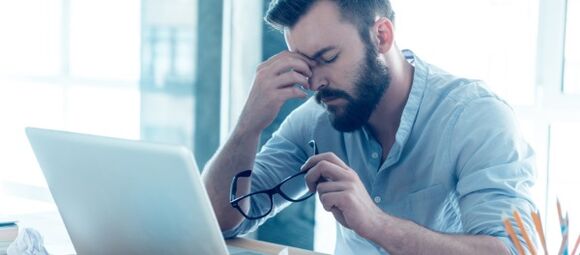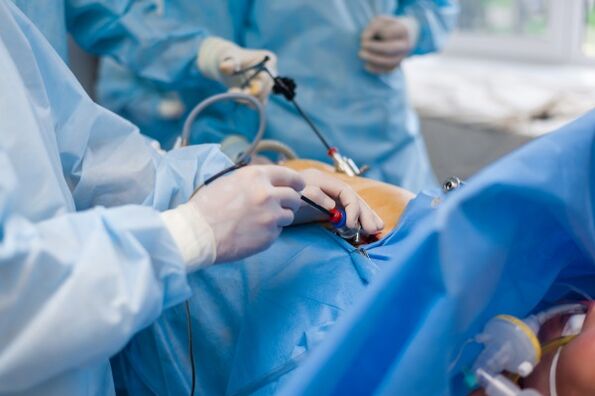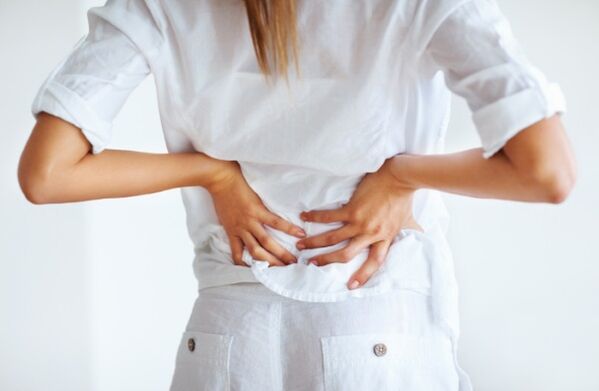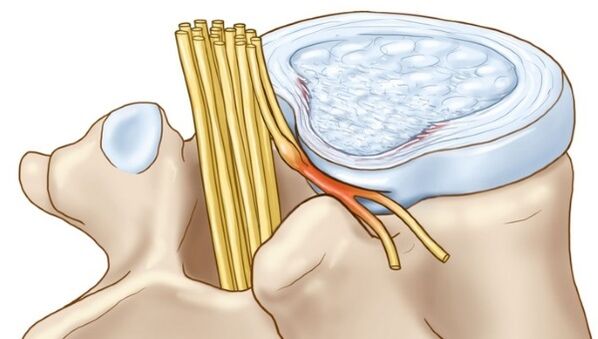Osteochondrosis of the lumbar spine is diagnosed not only in elderly patients. Recently, pathology occurs even in young people under the age of 30. Ignoring symptoms can lead to complications. Therefore, it is necessary to know the signs of the disease in order to start treatment in time.
What is lumbar osteochondrosis
This pathology involves the unhealthy transformation of vertebrae located in the lumbar region. With this disease, the elasticity of the intervertebral disc decreases due to a deficiency in the delivery of nutrients at the cellular level. The localization of this disease is due to the fact that it is this region of the spine that bears the greatest burden.
Cause
Among the main factors that lead to pathology are as follows:
- Genetics.Doctors warn that if one of the parents suffers from this disease, then the risk of developing lumbar osteochondrosis in the younger generation is much higher. Therefore, in such a situation, children need to be involved in prevention from childhood.
- Lift weights regularly.This applies not only to people who earn money through physical labor, but also to athletes who ignore safety precautions.
- injury.Any damage to the back can lead to pathology. If they are present, you should consult an osteopath or neurologist. It should be noted that many people are unaware of their injuries. For example, when braking suddenly while driving a car, a person may experience vertebral displacement.
- Obesity.The spine is able to withstand a load of normal weight. If a person is overweight, the lumbar region of this organ may become deformed.
- Poor posture.The curvature of the spine leads to a violation of the proportional distribution of loads and subsequently to osteochondrosis.
- Chronic physical inactivity,lack of movement in lifestyle. Minimal physical activity leads to the fact that the spine is not loaded. At such a moment, muscles and ligaments begin to weaken, and blood circulation is disrupted, which creates a lack of nutrition in the intervertebral disc, which loses its elasticity over time. In this case, the entire load and weight is transferred to the disc, squeezing and then forming a hernia.
- Flat feet.This pathology indicates a lack of normal shock absorption in the legs. This results in the spine having to do more work than during normal walking. Therefore, the vertebrae wear out faster.
- Pressure.The human body is designed in such a way that with any psycho-emotional stress, first of all, the neck becomes tense. This is a biological atavism. After all, when a predator attacks a mammal, it immediately grabs its neck. Chronic stress causes a spasm reflex shift throughout the spine. Ultimately, this can cause pinched nerves, including in the lumbar spine. Therefore, after stress, it is important to relieve tension with the help of special gymnastics.
- Aggressive obstetric practice. When the birth process is stimulated, the baby passes through the passage faster and can be injured as a result. This condition can occur during a cesarean section when the baby's head tilts strongly to the right or left side. After that, the baby was diagnosed with vegetative-vascular dystonia. The true cause of the pathology is usually identified in adolescence.


Degree
Osteochondrosis of the lumbar spine, the symptoms and treatment of which are described in detail in this article, has 4 stages of development. Their detailed description is presented in the table.
| Degree | Physiology | A painful sensation |
|---|---|---|
| First | The process of destruction of the intervertebral disc located in this area begins. | Expressed by burning, dull pain or tingling in the lumbar region. Sometimes the localization of unpleasant symptoms moves to the back. The pain syndrome becomes more pronounced after physical labor. |
| Second | Discs are more and more susceptible to destruction, under its influence the distance between them is significantly reduced. At this stage, protrusions may appear. | Pain becomes a constant pain character. They can radiate to the buttocks, thighs and knees. |
| Third | The tissue in this location of the spine is completely exposed to destruction. An intervertebral hernia is formed. | The pain is intense and constant. However, they do not depend on the level of physical activity. |
| Fourth | The cartilage completely atrophies, and the vertebrae begin to grow. The spine loses mobility, which leads to disability. | Unpleasant sensations can disappear completely or partially. |
Diagnostics
To make a correct diagnosis, the doctor performs the following activities:
- Inspection.At the initial appointment, the specialist visually assesses the patient's physique, weight ratio and height. In addition, the characteristics of walking, posture and doing exercises are easy to learn. The back skin is examined for the presence of inflamed areas.
- Palpate.The doctor carefully palpates the patient's back to identify the location of tension and pain. In some cases, a special hammer is used.
- Radiography.This diagnostic method is performed in two positions, back and side. If a functional study is required, then the radiation is carried out in a bent and unbent state. This method of diagnosis has become widespread in the CIS countries and requires the least amount of money. However, it does not allow identifying pathology at an early stage of development. In addition, X-rays are a dangerous type of radiation.
- CT scan.Unlike radiography, it makes it possible to obtain images of the best quality. This process is performed using a tomograph and takes about 10 minutes. As a result, it is possible to study in detail not only the state of bone tissue, but also changes in blood vessels and nerves. This method is not suitable for pregnant and lactating women. It should be noted that, despite the possibility of obtaining more detailed information, patients experience 5 times more radiation than radiography. It is recommended to conduct such an examination no more than once a year.
- Magnetic resonance imaging.It is the most informative way to make a diagnosis. During the procedure, the patient is placed on an airplane, which is rolled into a special chamber, where, using magnetic waves that pass through the patient's body, a detailed image of the spine is obtained. The main disadvantage of this diagnosis is the need for the patient to remain in the room for about 30 minutes. For people with a certain mental makeup, the procedure can be a difficult test. In addition, MRI is contraindicated in patients with pacemakers or metal parts in the body, as well as in women in early pregnancy. However, this diagnostic method has many advantages, the main one being the absence of harmful effects on the human body. The resulting image will clearly show not only changes in the vertebra itself, but also the direction of blood flow, the condition of nerve endings and blood vessels. Unlike previous methods of diagnosis, MRI can detect any unfavorable changes in the spine at the earliest stages of lumbar osteochondrosis.
- Blood and urine tests.This procedure cannot be called fully diagnostic. They are necessary as an additional examination, which is carried out to exclude or confirm rheumatological pathology.

Treatment
Osteochondrosis of the lumbar spine, symptoms vary in degreethe development of the disease described above, suggests the following treatment tactics:
- take medication prescribed by a doctor;
- physiotherapy courses;
- regular performance of special training sets;
- massage

In some cases, experts recommend surgery.
Drug treatment
All drugs prescribed for lumbar osteochondrosis can be divided into the following groups:
- painkillers;
- muscle relaxants;
- chondroprotector;
- vitamins.
Medicines that perform an analgesic function can be divided into two components: hormonal and non-steroidal anti-inflammatory drugs. They are equally able to eliminate not only pain, but also reduce inflammation.
However, the first group of drugs is used in exceptional cases. After all, they can cause an imbalance of the endocrine system and reduce immunity. Therefore, hormonal drugs can only be purchased after presenting a prescription at the pharmacy.
Osteochondrosis of the lumbar spine, the symptoms and treatment of which are described in detail in this article, involves the oral use or intramuscular administration of non-steroidal anti-inflammatory drugs.
However, its use for more than 3 days is not recommended. Otherwise, side effects may occur. Next, you can use various topical ointments and creams.
Oral medications are available in the form of tablets, injections and suppositories.
Injections are used to relieve inflammation and acute pain. It is forbidden to do it for more than 2 days.
Muscle relaxants help relax muscles. However, the danger of its use lies in the fact that this category of drugs blocks the impulses that go from the nerves to the muscles.
It should be explained that motor nerves exit the spinal cord to all muscle fibers through the spine.
When taking muscle relaxants, the impulse transmission mechanism is blocked. Due to pinching and overwork in lumbar osteochondrosis, the connection between nerves and muscles is already disturbed. The use of these drugs continues to depress this system.
Taking chondroprotectors triggers the recovery of cartilage tissue.
However, there is a theory that chondroprotectors cannot restore the intervertebral disc, because it consists of fibrous tissue. In this case, the drug acts exclusively on cartilage tissue.
B vitamins are needed to maintain nerve fibers.
Physiotherapy
All procedures related to physiotherapy affect the local pathological area, while nearby tissues and organs remain unchanged.
These include the following methods for treating lumbar osteochondrosis:
- Electrophoresis with anesthetic.A special medicine is injected into the patient's lower back. The entire process is stimulated by an electric current.
- Ultrasound.The purpose of this treatment method is tissue micromassage. This procedure helps relieve inflammation and also relieves pain. Blood circulation improves, and metabolism is activated accordingly.
- Magnetotherapy.This method involves the use of a magnetic field. There are different types of devices with the same effect, which make it possible to use them at home.
- Vibration effect.The device creates specific vibrations in the desired area of the body.
- Detensor therapy.This procedure is performed on a special mattress. The goal is to straighten the spine.
Physiotherapy
Osteochondrosis of the lumbar spine, the symptoms and treatment of which should be checked with a doctor, requires compliance with certain rules when doing exercises. The main principle is the immediate cessation of action when pain occurs. Move carefully and smoothly to avoid damage.
This complex assumes the following algorithm:
- Lie on your back and lift your legs one at a time.
- Turn onto your side with your arms stretched forward. Pull your upper leg back. Then switch to the other side and repeat the steps in a mirror manner.
- Lying on your stomach, simultaneously pull your legs and arms back.
- Get up on all fours. Take turns pulling back one hand at a time.
- In the same position, pull your right arm and leg up. Then repeat the same on the left side.

massage
When performing a massage, you must adhere to the following rules:
- action should be directed from the upper back down;
- massage movements can only affect soft tissue and not the spine;
- Before the procedure, the patient is advised to visit the toilet.
Massage algorithm:
- Make a shot in the right direction;
- Do a rubbing motion first with one, then with two palms. In this case, it is necessary to monitor the pressure applied by the massage therapist on the patient's back.
- Pull slowly and then squeeze the muscle tissue.
- Make vibrations using your hands or a special preparation.
- Complete the procedure with light stroking.
People's recovery
Traditional medicine involves the use of medicinal herbs. The main action is to relieve pain.
Homemade pain relief ointment
For this recipe, you need hop cones and animal fat. The first component is crushed and mixed with the second.

Next, the ointment should sit a little and can be applied to the lower back. The composition can be added with chamomile if desired. It has soothing properties and can relieve inflammation.
Compressed honey and potatoes
Raw potatoes must be chopped using a grater. Next, mix the components in equal proportions. The resulting mass should be distributed over the back pain area. It is advisable for the patient to remain in this position for several hours, and then rinse everything thoroughly. This compress temporarily relieves the patient's condition.
Pain relief ointment with ginger
Grind ginger and garlic in equal amounts on a fine grater. Then you need to add a little butter. Mix everything thoroughly and apply on the lower back. The ointment must be prepared immediately before use.
Purple alcohol color
Pour a small handful of purple flowers into a glass quart jar. Then fill the container to the neck with vodka, alcohol or moonshine. The jar must be tightly closed with a lid and left in a cool, dark place. After a week and a half, the product is ready to use.

In this case, there is no need to pass the tincture through a filter. You can rub your back with the resulting product. However, the dose should be minimal. If after use the product is stored in the same way as during the infusion, then it can be used for a whole year.
Herbal bath
Osteochondrosis of the lumbar spine, the symptoms and treatment of which can be studied in this article, is often accompanied by severe pain. You can remove it by taking a shower. Warm water helps to relax the soft tissues, ease the spasms, and make the pain go away.
In some cases, experts recommend using different temperatures to relieve inflammation. It should be noted that taking a warm bath accelerates metabolic processes in the body. Another advantage of this method of treating pathology is the possibility of using it at home. In addition, the procedure helps relieve psycho-emotional nervous tension.
You can improve efficiency with the help of herbal baths, among which the following should be highlighted:
- conifers.It is better to use needles from 3 trees - pine, spruce and cedar. You can also add cones. About 5 handfuls of the collected material should be boiled for about 15 minutes. Then, without opening the lid, leave it for 2 hours. Then pass the broth through a strainer and pour it into the bathtub.
- Chamomile.For this recipe it is not necessary to use fresh flowers; you can use a ready-made pharmacy mixture. A glass of chamomile should be filled with water and heated over low heat.
 You can not boil the stew. When the peak temperature is reached, the heating must be turned off. Without opening the lid, let it brew for another 3 hours. After that, the composition can be used. Such a bath will be useful not only for osteochondrosis, but also in the presence of redness and inflammatory processes on the skin.
You can not boil the stew. When the peak temperature is reached, the heating must be turned off. Without opening the lid, let it brew for another 3 hours. After that, the composition can be used. Such a bath will be useful not only for osteochondrosis, but also in the presence of redness and inflammatory processes on the skin. - Juniper.Boil several handfuls of the mixture for about 20 minutes. Then the broth must be passed through a filter. In this case, there is no need to wait until the composition has completely cooled, you can immediately pour it into the bathtub. This procedure brings with it an additional aromatherapy effect, which helps to relieve stress and relieve insomnia.
After any of the above baths, you need to lie down for about an hour. It is best to carry out the procedure before going to bed at night.
Surgical intervention
Despite the fact that this disease can be treated effectively with conservative treatment, in some cases patients are recommended to undergo surgery. It is important to note that it must be carried out on time. After all, sometimes it happens that a person becomes disabled just because he did not consult a doctor in time about complications.
The following indications are required for surgical intervention:
- prolonged two-month pain, which is eliminated with the help of non-steroidal drugs;
- progressive problems with motor function.
There are the following types of operations performed for lumbar osteochondrosis:
- Discectomy.Represents a replacement disk. It can be partial or complete.
- Foraminotomy.During surgery, part of the damaged tissue is removed. The operation is performed under local anesthesia.
- Laminotomy.The surgeon removes part of the osteophyte.
- Facetectomy.This operation aims to remove the joint. It is performed under general anesthesia.
- Laminectomy.This surgery is done to remove part of the spine. At the same time, the remaining parts are fixed.

What to do during an exacerbation
During the exacerbation of the disease, it is better to adhere to the following recommendations:
- prefer hard chairs to soft ones;
- sleep on an orthopedic mattress;
- avoid heavy lifting;
- change your body position every quarter of an hour;
- do the massage.

Complications
Lack of treatment for lumbar osteochondrosis can cause changes in the normal location of the disc. A hernia is formed between the 5th vertebra and the sacrum. In addition, this pathology interferes with blood circulation in the pelvis. In men, this leads to erectile dysfunction and possibly impotence.

For women, this disease threatens problems in the reproductive system. However, the most severe complication is disability, which begins with a gradual deterioration of motor activity.
Osteochondrosis of the lumbar spine has characteristic symptoms. The above complications show that it is dangerous to ignore them. After all, modern medicine offers a variety of treatment options that provide effective results.
































